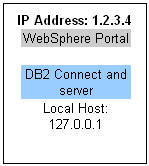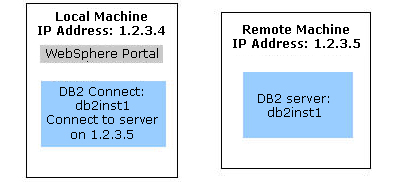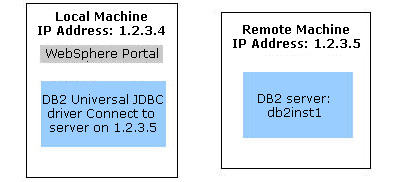Portal Express, Version 6.0
Operating systems: i5/OS, Linux, Windows
Plan for DB2
This section provides information to give the database administrator an overall picture of WebSphere Portal Express database requirements.
See the following links if you need help determining which DB2 version to use.
- Which Distributed Edition of DB2 Universal Database Version 8 is Right for You?
- Which Distributed Edition of DB2 Universal Database Version 9 is Right for You?
Before you begin:
- You should have reviewed the Planning for databases topic to determine if you are going to transfer WebSphere Portal Express data to another supported database.
- Ensure the database you plan to use is supported by this version of WebSphere Portal Express. Refer to Supported hardware and software for supported database that are needed for WebSphere Portal Express.
Plan
The following areas provide an overview of the database and user names used in the documentation as well as some information about each database and user you should consider in your planning. The database names and users on this page are suggested values and provide consistency throughout the documentation. During your implementation, replace these values with values in your environment.
Notes:
- After the database software has been installed, create the required databases and users and grant the proper privileges to those users.
- The Feedback function is not configured by default. It must first be turned on by following the steps in Enable logging, otherwise the Feedback tables will not be created in the new database.
- The database name cannot exceed eight characters and can only contain letters and numbers.
- DB2 Content Manager Runtime Edition is a data repository that runs on DB2 to store data for applications such as Personalization, Document Manager, and Web Content Management.
- If you are using one of the following fix packs complete the steps below prior to database transfer. Failure to follow these steps will cause the database transfer to hang at the task action-process-constraints.
- DB2 8.1 Fix Pack 10
- DB2 8.1 Fix Pack 11
- DB2 8.1 Fix Pack 12
- DB2 8.1 Fix Pack 13
 DB2 8.1
Fix Pack 14
DB2 8.1
Fix Pack 14
 DB2 9.1
Fix Pack 1
DB2 9.1
Fix Pack 1
- Locate the following file:
- Linux:
/home/db2inst1/sqllib/cfg/db2cli.ini
- Windows:
db2home/sqllib/db2cli.ini
- Linux:
- Edit the file by adding the following to the end of the file:
- For Fix Pack 10 or Fix Pack 11:
[COMMON] DYNAMIC=1
An empty line is required after the dynamic=1 at the end of the file.
 For all other Fix Packs listed above:
For all other Fix Packs listed above:
[COMMON] DYNAMIC=1 ReturnAliases=0
An empty line is required after the ReturnAliases=0 at the end of the file.
- For Fix Pack 10 or Fix Pack 11:
Notes:
- This fix should be applied to both the client side and server side of the DB2 installation.
 If you are using DB2 type 4 JDBC driver at the client side, the fix should be applied to the server side only.
If you are using DB2 type 4 JDBC driver at the client side, the fix should be applied to the server side only.
The following sections provide an overview of the different databases and database user names you should consider in your planning. While configuring WebSphere Portal Express to use one database is technically possible, we strongly recommend using separate databases for scalability and performance tuning reasons. To use a single shared database, replace each database and user variable with the name of your database and database user, respectively; schema names must be different when the database is shared.
Databases
The following table demonstrates the information each application will store in the databases.
| Application | Database Name | Instance* | Function | Space considerations |
|---|---|---|---|---|
| WebSphere Portal Express |
| db2inst1 | Used for WebSphere Portal Express (at a minimum) or to hold all data. Stores information about user customization, such as Pages, and user profile and login information. | The amount of database space that is required depends on the number of WebSphere Portal Express users and objects, such as pages and portlets. |
| Member Manager | wmmdb | db2inst1 | Used for Member Manager if the data is not stored on the WebSphere Portal Express database. Stores information about users and groups. Dependent on the configuration of users, groups and their relationship, or only additional attributes are stored | The amount of this database depends on the number of Users and groups you are storing within your database repository. If your user repository is an LDAP this database is not used. |
| Document Manager, Personalization, Web Content Management | jcrdb | db2inst1 | Used by Document Manager, Personalization, and Web Content Management components. Contains documents, personalization rules, personalization campaigns, and document library configuration information. | The amount of database space that is required depends on the size and number of documents created and uploaded by the Document Manager, the number and size of Personalization rules and campaigns, and the number and size of items and elements created in Web Content Management. |
| Feedback | fdbkdb | db2inst1 | Used by Feedback components. Contains the information that is logged by your web site for generating reports for analysis of site activity. | The amount of database space that is required for logging depends on the amount of traffic to the site. The amount of data that is logged per login-enabled page can vary. |
| Likeminds | lmdb | db2inst1 | Used for LikeMinds data. Contains the recommendations to be displayed to users when their interactions with your Web site have been analyzed and predictions generated. | The amount of database space that is required depends on the amount of traffic to the site. |
- The WebSphere Portal Express architecture allows each of these databases to exist in one or many instances. However, the recommended architecture uses the default instance (shown above as db2inst1) that is created by the DB2 installation program.
Users
The following table demonstrates the number of tables and types of objects owned by each user. The WebSphere Portal Express architecture allows each of the following users to exist in the same database.
All tablespaces will be approximately 2.8 GB by default. The size will increase with the use of the DB2 Content Manager Runtime Edition function.
| Application | Database user placeholder | Recommended name | Function |
| WebSphere Portal Express |
| <none> | Core user. Will own approximately 130 tables for each domain. Owns WebSphere Portal Express core objects, which includes tables that store the user customizations made to Pages. |
| DB2 Content Manager Runtime Edition | icmadmin | <none> | DB2 Content Manager Runtime Edition user. Will own at least 1130 tables; the number could be higher depending on usage. |
| Member Manager | wmmdbusr | <none> | Member Manager user. Will own approximately 35 tables. Owns the Member Manager objects, which includes the tables that store login information about WebSphere Portal Express users. |
| Feedback | feedback | <none> | Feedback user. Will own approximately 50 tables used for logging site and personalization usage. |
| Likeminds | lmdbusr | <none> | LikeMinds user. Will own approximately 15 tables used to hold the web site usage analysis routines and recommendation text. |
DB2 architecture
In a local database environment, WebSphere Portal Express and DB2 are installed on the same machine.
Figure 1. Local Database Environment
In a remote database environment, WebSphere Portal Express and a DB2 Connect are installed on one machine (the local machine). The DB2 server is installed on a separate machine (the remote machine).
 In a remote database environment, there are two connection types. Either WebSphere Portal Express connects to the DB2 server system using a local DB2 Connect installation (JDBC type 2 connection) or connects directly to the DB2 server (JDBC type 4 connection). If JDBC type 2 connections are used,WebSphere Portal Express and a DB2 Connect are installed on one machine (the local machine). The DB2 server is installed on a separate machine (the remote machine).
In a remote database environment, there are two connection types. Either WebSphere Portal Express connects to the DB2 server system using a local DB2 Connect installation (JDBC type 2 connection) or connects directly to the DB2 server (JDBC type 4 connection). If JDBC type 2 connections are used,WebSphere Portal Express and a DB2 Connect are installed on one machine (the local machine). The DB2 server is installed on a separate machine (the remote machine).
Figure 2. Remote Database Environment (JDBC type 2 connection)

For JDBC type 4 connections no DB2 Connect installation is required on the machine that runs WebSphere Portal Express. The DB2 Universal JDBC driver that is supplied with DB2 is copied to this machine. It is used within the Java Virtual Machine of WebSphere Portal Express and connects directly to the remote DB2 server.
Figure 3. Remote Database Environment (JDBC type 4 connection)
Next steps
You have completed this step. Continue to the next step.
Parent topic:
Configuring DB2